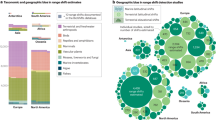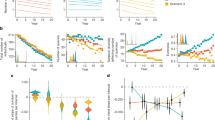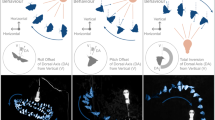Abstract
LIGHT TRAPS of various forms have been used to collect and study moths for well over 100 yr, but surprisingly little is known about how they attract moths. There has been some evaluation of the factors influencing the size of light trap catches1–5 and of the mechanics of the terminal phase of the moth's approach to a light6, but virtually nothing is understood about the light-trap response itself. Such an understanding is perhaps unnecessary when light traps are used solely to collect specimens, but becomes crucial as soon as they are used for quantitative sampling or survey work7. Of particular importance to the interpretation of such work is a knowledge of the distance from which moths orientate with respect to a light source; it seems intuitively that this distance should be fairly large. We present here the results of three experiments designed to determine the distance of response of free-flying moths to an artificial light source. Our results support Sotthibandhu's claim4 that the effective range of a 125 W mercury vapour (MV) lamp is about 3 m. They also lead to speculation concerning the behavioural meaning of the light trap response in moths.
This is a preview of subscription content, access via your institution
Access options
Subscribe to this journal
Receive 51 print issues and online access
$199.00 per year
only $3.90 per issue
Buy this article
- Purchase on Springer Link
- Instant access to full article PDF
Prices may be subject to local taxes which are calculated during checkout
Similar content being viewed by others
References
Williams, C. B. Phil. Trans. B 244, 331–378 (1961).
Taylor, L. R. & Carter, C. I. Trans. R. ent. Soc., Lond. 113, 369–386 (1961).
Schaefer, G. W. in Insect flight, Symp. R. ent. Soc. Lond. no. 7 (ed. Rainey, R. C.) 157–197 (Blackwell, London, 1976).
Sotthibandhu, S. thesis, Univ. Manchester (1978).
Mikkola, K. Ann. Zool. Fennica 9, 225–254 (1972).
Hsiao, H. S. Attraction of moths to light and to infrared radiation (San Francisco Press, 1972).
Taylor, L. R., Kempton, R. A. & Woiwod, J. P. J. Anim. Ecol. 45, 255–272 (1976).
Bowden, J. & Morris, M. S. Bull. ent. Res. 65, 303–348 (1975).
Sotthibandhu, S. & Baker, R. R. Anim. Behav. 27 (in the press).
Agee, H. R. Ann. Ent. Soc. Am. 65, 701–705 (1972).
Buddenbrock, W. von Grundriss der vergleichenden Physiologic (Berlin, 1937).
Callahan, P. S. Nature, 206, 1172–1173 (1965).
Laithwaite, E. R. Entomologist 93, 133–137 (1960).
Roeder, K. D. in Animal Behavior: Readings from Scient. Am. (Eds Eisner, T. & Wilson, E. O.) 46–54 (W. H. Freeman, San Francisco, 1975).
Baker, R. R. The Evolutionary Ecology of Animal Migration (Hodder and Stoughton, London, 1978).
Bailey, N. T. J. J. Anim. Ecol. 21, 120–127 (1952).
Author information
Authors and Affiliations
Rights and permissions
About this article
Cite this article
BAKER, R., SADOVY, Y. The distance and nature of the light-trap response of moths. Nature 276, 818–821 (1978). https://doi.org/10.1038/276818a0
Received:
Accepted:
Published:
Issue Date:
DOI: https://doi.org/10.1038/276818a0
This article is cited by
-
Global meta-analysis reveals overall higher nocturnal than diurnal activity in insect communities
Nature Communications (2024)
-
Why flying insects gather at artificial light
Nature Communications (2024)
-
Dose–effects in behavioural responses of moths to light in a controlled lab experiment
Scientific Reports (2023)
-
Self-organized multi-target trapping of swarm robots with density-based interaction
Complex & Intelligent Systems (2023)
-
Attractivity of various artificial light sources to caddisfly (Trichoptera) species and its importance in their sampling and conservation
Journal of Insect Conservation (2022)
Comments
By submitting a comment you agree to abide by our Terms and Community Guidelines. If you find something abusive or that does not comply with our terms or guidelines please flag it as inappropriate.



